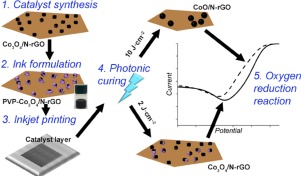Applied Catalysis A: General ( IF 5.5 ) Pub Date : 2018-06-19 , DOI: 10.1016/j.apcata.2018.06.026 Victor Costa Bassetto , Jingjing Xiao , Emad Oveisi , Véronique Amstutz , Baohong Liu , Hubert H. Girault , Andreas Lesch

|
The accurate and reproducible large-scale production of catalyst layers containing low-cost, abundant electrocatalysts gains in importance. Herein, pivotal factors are discussed that need to be considered when a combined inkjet printing and photonic curing platform is used as a promising fabrication method for catalyst layers based on a model low-cost catalyst, i.e., nitrogen-doped reduced graphene oxide supported cobalt oxide nano sheets (Co3O4/N-rGO), specifically prepared to formulate an inkjet ink. The ink is stable for weeks and can reproducibly be printed with piezoelectric printheads. Ink composition and printing parameters are optimized to achieve high-resolution printing and good adhesion on glassy carbon substrates. Polyvinylpyrrolidone and ethyl cellulose are used as catalyst stabilizers in the ink and must be removed through thermal post-processing to avoid a decrease of the electrical conductivity of the catalyst layer and a degradation of the catalytic activity of the Co3O4 nanocrystals. Conventional slow oven curing (i.e., hours) and photonic curing with a Xe flash lamp (seconds) are compared to generate temperatures above 400 °C under ambient conditions. Both techniques can increase the size of the Co3O4 nanocrystals from ∼7 nm up to ∼15 nm. Photonic curing with pulses above 2 J·cm–2 shot energy density initiates the reduction of the oxidation states of cobalt from (II,III) to (II). Residues and side products of polymeric stabilizers can be found using photonic curing pulses below 10 J·cm–2. This work highlights the advances made in digital printing and post-processing for catalyst layer production and demonstrates the importance of proper design of the ink, the printing and the post-processing for the large-scale production of catalyst layers for the ORR based on low-cost materials. The findings can be transferred to other metal and mixed metal oxide nanocatalysts.
中文翻译:

高催化活性的Co 3 O 4 / N-rGO层的快速喷墨印刷用于氧还原反应
准确且可重现的大规模生产包含低成本,丰富电催化剂的催化剂层变得越来越重要。在此,讨论了将喷墨印刷和光子固化平台组合用作基于模型低成本催化剂的有前途的催化剂层制造方法时需要考虑的关键因素,即,氮掺杂的还原氧化石墨烯负载的氧化钴纳米片(Co 3 O 4/ N-rGO),专门用于配制喷墨油墨。墨水可以稳定保存数周,并且可以用压电打印头可重复打印。优化了墨水成分和印刷参数,以实现高分辨率印刷和在玻璃碳基材上的良好附着力。聚乙烯吡咯烷酮和乙基纤维素在油墨中用作催化剂稳定剂,必须通过热后处理除去,以避免催化剂层电导率降低和Co 3 O 4纳米晶体的催化活性下降。传统的慢速烤箱固化(即(小时)和使用Xe闪光灯进行光子固化(秒)进行比较,以在环境条件下产生高于400°C的温度。两种技术都可以将Co 3 O 4纳米晶体的尺寸从约7 nm增加到约15 nm。脉冲能量密度大于2 J·cm –2的光子固化会引发钴的氧化态从(II,III)还原为(II)。使用低于10 J·cm –2的光子固化脉冲可以发现聚合物稳定剂的残留物和副产物。这项工作突出了在数字印刷和催化剂层生产的后处理方面取得的进展,并展示了正确设计油墨,对于大规模生产基于ORR的ORR催化剂层的印刷和后处理的重要性。成本材料。研究结果可以转移到其他金属和混合金属氧化物纳米催化剂中。

























 京公网安备 11010802027423号
京公网安备 11010802027423号